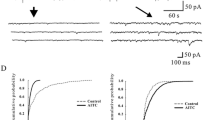Abstract
The effects of externally applied 3-isobutyl-1-methylxanthine (IBMX), in millimolar concentrations, on the membrane currents in dorsal root ganglia (DRG) neurones isolated from newborn rats were investigated using the amphotericin-based “perforated” patch-clamp technique. In some experiments, simultaneous measurements of intracellular Ca2+ concentration ([Ca2+]in) were performed using fura-2 microfluorimetry. Applications of IBMX induced elevation of [Ca2+]in resulting from Ca2+ release from caffeine-ryanodine-sensitive internal stores. In addition to Ca2+ release, IBMX produced a biphasic membrane current response comprised of an inward current transiently interrupted by outward current. The onset of the inward current slightly preceded the onset of the [Ca2+]in transient, while the interrupting outward current developed synchronously with the [Ca2+]in rise. The development of IBMX-induced outward current ultimately needed the [Ca2+]in elevation. After the depletion of Ca2+ stores by IBMX or caffeine exposure, the subsequent IBMX challenge failed to produce both the [Ca2+]in transient and outward membrane current, although the inward current remained unchanged. Both components of the IBMX-induced membrane current response had a reversal potential close to the K+ equilibrium potential and the IBMX-induced membrane current response disappeared while dialysing the cell interior with K+-free, Cs+-containing solutions suggesting their association with K+ channel activity. External administration of 10 mM tetraethylammonium chloride (TEA-Cl) evoked an inward current similar to that observed in response to IBMX; in the presence of TEA-Cl, IBMX application was almost unable to induce additional inward current. IBMX (5 mM) effectively (≈50%) inhibited K+ currents evoked by step depolarizations of membrane potential. We suggest that IBMX affects membrane permeability via activation of Ca2+-regulated K+ channels and direct inhibition of TEA-sensitive K+ channels.
Similar content being viewed by others
References
Adams PR, Brown DA (1982) Synaptic inhibition of the M-current: slow excitatory post-synaptic mechanism in bullfrog sympathetic neurones. J Physiol (Lond) 332:263–272
Adams PR, Brown DA, Constanti A (1982) Pharmacological inhibition of the M-current. J Physiol (Lond) 332:223–262
Adams PR, Constanti A, Brown DA, Clark RB (1982) Intracellular Ca2+ activates a fast voltage-sensitive K+ current in vertebrate sympathetic neurones. Nature 296:746–749
Akaike N, Sadoshima J (1989) Caffeine affects four different ionic currents in the bull-frog sympathetic neurones. J Physiol (Lond) 412:221–244
Brown DA (1988) M-currents. In: Ion channels. Plenum, New York, pp 55–94
Brown DA, Constanti A, Adams PR (1983) Ca-activated potassium current in vertebrate sympathetic neurones. Cell Calcium 4:407–420
Daly JW (1993) Mechanism of action of caffeine. In: Caffeine, coffee, and health. Raven, New York, pp 97–150
Friel DD, Tsien RW (1992) A caffeine- and ryanodine-sensitive Ca2+ store in bullfrog sympathetic neurones modulates effects of Ca2+ entry on [Ca2+]i. J Physiol (Lond) 450:217–246
Grynkiewicz G, Poenie M, Tsien RY (1985) A new generation of Ca2+ indicators with greatly improved fluorescent properties. J Biol Chem 260:3440–3450
Hamill OP, Marty A, Neher E, Sakmann B, Sigworth FJ (1981) Improved patch clamp techniques for high-resolution current recording from cell and cell-free membrane patches. Pflügers Arch 391:85–100
Horn R, Marty A (1988) Muscarinic activation of ionic currents measured by a new whole-cell recording method. J Gen Physiol 92:145–159
Koketsu K, Akasu T, Miyagawa M (1982) Identification of gK systems activated by [Ca2+]. Brain Res 243:369–372
Kostyuk P, Verkhratsky A (1994) Calcium stores in neurones and glia. Neuroscience 63:381–404
Marrion NV, Adams PR (1992) Release of intracellular calcium and modulation of membrane currents by caffeine in bullfrog sympathetic neurones. J Physiol (Lond) 445:515–535
Munakata M, Akaike N (1993) Theophylline affects three different potassium currents in dissociated rat cortical neurones. J Physiol (Lond) 471:599–616
Pfaffinger PJ, Leibowitz MD, Subers EM, Nathanson NM, Almers W, Hille B (1988) Agonists that suppress M-current elicit phosphoinositide turnover and Ca2+ transients, but these events do not explain M-current suppression. Neuron 1:477–484
Robbins J, Trouslard J, Marsh SJ, Brown DA (1992) Kinetic and pharmacological properties of the M-current in rodent neuroblastoma x glioma hybrid cells. J. Physiol (Lond) 451: 159–185
Sadoshima J, Akaike N (1991) Kinetic properties of the caffeine-induced transient outward current in bull-frog sympathetic neurones. J Physiol (Lond) 433:341–355
Satin LS, Adams PR (1987) Spontaneous miniature outward currents in cultured bullfrog neurons. Brain Res 401:331–339
Shmigol A, Kirischuk S, Kostyuk P, Verkhratsky A (1994) Different properties of caffeine-sensitive Ca2+ stores in peripheral and central mammalian neurones. Pflügers Arch 426:174–176
Smart TG (1987) Single calcium activated potassium channels recorded from cultured rat sympathetic neurones. J Physiol (Lond) 389:337–360
Uneyama H, Munakata M, Akaike N (1993) Caffeine response in pyramidal neurons freshly dissocated from rat hippocampus. Brain Res 604:24–31
Usachev Y, Verkhratsky A (1995) IBMX induces calcium release from intracellular stores in rat sensory neurones. Cell Calcium 17:197–206
Usachev Y, Shmigol A, Pronchuk N, Kostyuk P, Verkhratsky A (1993) Caffeine-induced calcium release from internal stores in rat sensory neurones. Neuroscience 57:845–859
Yu SP, O'Malley DM, Adams PR (1994) Regulation of M current by intracellular calcium in bullfrog sympathetic ganglion neurons. J Neurosci 14:3487–3499
Author information
Authors and Affiliations
Rights and permissions
About this article
Cite this article
Usachev, Y., Kostyuk, P. & Verkhratsky, A. 3-Isobutyl-1-methylxanthine (IBMX) affects potassium permeability in rat sensory neurones via pathways that are sensitive and insensitive to [Ca2+]in . Pflügers Arch 430, 420–428 (1995). https://doi.org/10.1007/BF00373918
Received:
Revised:
Accepted:
Issue Date:
DOI: https://doi.org/10.1007/BF00373918



